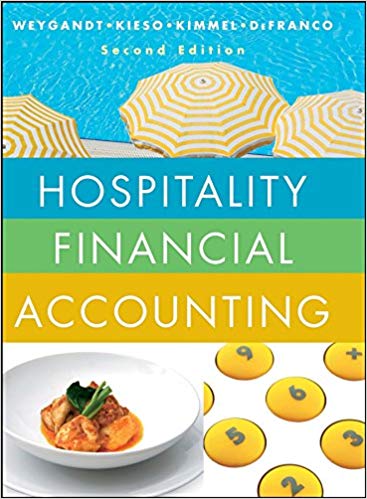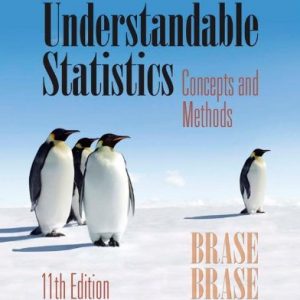This is completed downloadable of Solution Manual for Hospitality Financial Accounting 2nd by Weygandt

Product Details:
- ISBN-10 : 0470083603
- ISBN-13 : 978-0470083604
- Author:
As the hospitality field continues to grow and diversify, today’s hospitality professionals need to understand financial accounting at a higher level than ever before. Written by some of the most respected authors in accounting, Hospitality Financial Accounting, Second Edition gives a complete introduction to financial accounting principles and demonstrates how to apply them to all facets of the hospitality industry.
Updated with the latest developments in the accounting and hospitality fields,Hospitality Financial Accounting, Second Edition covers the basics of financial accounting first and then shows hospitality students how to analyze financial statements and deal with the daily issues they will face on the job.
Table of Content:
- 1: Hospitality Accounting in Action
- FEATURE STORY: Financial Reporting: A Matter of Trust
- What Is Accounting?
- Who Uses Accounting Data?
- Brief History of Accounting
- Distinguishing between Bookkeeping and Accounting
- Accounting and You
- The Building Blocks of Accounting
- Ethics—A Fundamental Business Concept
- Generally Accepted Accounting Principles
- Assumptions
- Basic Accounting Equation
- The Accounting Cycle and the Flow of Information
- The Uniform System of Accounts and Financial Reporting
- Lodging Industry
- Foodservice Industry
- Club Industry
- Spa Industry
- Gaming Industry
- Accounting and Financial Management in Hospitality
- Hotel Operations
- Hotel Accounting Department Organization
- Foodservice Operations
- Club Operations
- CHAPTER 1 Appendix The Accounting Profession
- Public Accounting
- Private Accounting
- Not-for-Profit Accounting
- 2: Accounting Principles
- FEATURE STORY: Certainly Worth Investigating!
- The Conceptual Framework of Accounting
- Objectives of Financial Reporting
- Qualitative Characteristics of Accounting Information
- Elements of Financial Statements
- Operating Guidelines
- Assumptions
- Monetary Unit Assumption
- Economic Entity Assumption
- Time Period Assumption
- Going Concern Assumption
- Principles
- Revenue Recognition Principle
- Matching Principle (Expense Recognition)
- Full Disclosure Principle
- Cost Principle
- Constraints in Accounting
- Materiality
- Conservatism
- Summary of Conceptual Framework
- Financial Statement Presentation—An International Perspective
- Using the Building Blocks
- Transaction Analysis
- Summary of Transactions
- Financial Statements
- Income Statement
- Retained Earnings Statement
- Balance Sheet
- Statement of Cash Flows
- 3: The Recording Process
- FEATURE STORY: No Such Thing as a Perfect World
- The Account
- Debits and Credits
- Debit and Credit Procedures
- Stockholders’ Equity Relationships
- Expansion of the Basic Equation
- The Accounting Cycle
- Steps in the Recording Process
- The Journal
- The Ledger
- The Recording Process Illustrated
- Summary Illustration of Journalizing and Posting
- The Trial Balance
- Limitations of a Trial Balance
- Locating Errors
- Use of Dollar Signs
- Electronic Data Processing
- Comparative Advantages of Manual versus Computerized Systems
- A Look into the Future
- 4: Adjusting the Accounts
- FEATURE STORY: Timing Is Everything
- Timing Issues
- Selecting an Accounting Time Period
- Fiscal and Calendar Years
- Accrual- versus Cash-Basis Accounting
- Recognizing Revenues and Expenses
- The Basics of Adjusting Entries
- Types of Adjusting Entries
- Adjusting Entries for Prepayments
- Adjusting Entries for Accruals
- Summary of Basic Relationships
- The Adjusted Trial Balance and Financial Statements
- Preparing the Adjusted Trial Balance
- Preparing Financial Statements
- Alternative Treatment of Prepaid Expenses and Unearned Revenues
- Prepaid Expenses
- Unearned Revenues
- Summary of Additional Adjustment Relationships
- 5: Completion of the Accounting Cycle
- FEATURE STORY: Everyone Likes to Win
- Using a Work Sheet
- Steps in Preparing a Work Sheet
- Preparing Financial Statements from a Work Sheet
- Preparing Adjusting Entries from a Work Sheet
- Closing the Books
- Preparing Closing Entries
- Closing Entries, Illustrated
- Posting of Closing Entries
- Preparing a Postclosing Trial Balance
- Summary of the Accounting Cycle
- Correcting Entries—An Avoidable Step
- Classified Balance Sheet
- Standard Classifications
- Classified Balance Sheet, Illustrated
- 6: Financial Statements
- FEATURE STORY: Cash Is King
- The Income Statement
- Multiple-Step Income Statement
- Single-Step Income Statement
- Departmental Income Statement
- Consolidated Income Statement
- Classified Balance Sheet
- Relationship between the Income Statement and the Balance Sheet
- The Statement of Cash Flows: Purpose and Format
- Purpose of the Statement of Cash Flows
- Meaning of Cash Flows
- Classification of Cash Flows
- Significant Noncash Activities
- Format of the Statement of Cash Flows
- Usefulness of the Statement of Cash Flows
- Preparing the Statement of Cash Flows
- Indirect and Direct Methods
- Indirect Method for Statement of Cash Flows
- First Year of Operations—2008
- Second Year of Operations—2009
- 7: Financial Statement Analysis
- FEATURE STORY: “Follow That Stock!“
- Basics of Financial Statement Analysis
- Need for Comparative Analysis
- Tools of Financial Statement Analysis
- Horizontal Analysis
- Balance Sheet
- Income Statement
- Retained Earnings Statement
- Vertical Analysis
- Balance Sheet
- Income Statement
- Ratio Analysis
- Liquidity Ratios
- Profitability Ratios
- Solvency Ratios
- Summary of Ratios
- Limitations of Financial Statement Analysis
- Estimates
- Cost
- Alternative Accounting Methods
- Atypical Data
- Diversification of Firms
- 8: Accounting for Merchandising Operations in Hospitality
- FEATURE STORY: Selling Dollars for 85 Cents
- Merchandising Operations
- Operating Cycles
- Inventory Systems
- Recording Purchases of Merchandise
- Purchase Returns and Allowances
- Freight Costs
- Purchase Discounts
- Recording Sales of Merchandise
- Sales Returns and Allowances
- Sales Discounts
- Completing the Accounting Cycle
- Adjusting Entries
- Closing Entries
- Summary of Merchandising Entries
- Work Sheet for a Merchandiser
- Using a Work Sheet
- 9: Inventories and Cost of Goods Calculation
- FEATURE STORY: $12,800 Worth of Blueberry Muffins!
- Inventory Basics
- Classifying Inventory
- Determining Inventory Quantities
- Inventory Accounting Systems
- Periodic Inventory System
- Recording Transactions
- Recording Purchases of Merchandise
- Recording Sales of Merchandise
- Cost of Goods Sold
- Determining Cost of Goods Purchased
- Transfers In and Out
- Food Cost Calculations
- Beverage Cost Calculations
- Income Statement Presentation
- Inventory Costing under a Periodic Inventory System
- Using Actual Physical Flow Costing—Specific Identification
- Using Assumed Cost-Flow Methods—FIFO, LIFO, and Average Cost
- Financial Statement Effects of Cost–Flow Methods
- Using Inventory Cost-Flow Methods Consistently
- Inventory Errors
- Income Statement Effects
- Balance Sheet Effects
- Statement Presentation and Analysis
- Presentation
- Analysis
- 10: Internal Control and Cash
- FEATURE STORY: Minding the Money in Moose Jaw
- Internal Control
- Principles of Internal Control
- Limitations of Internal Control
- Cash Controls
- Internal Control over Cash Receipts
- Internal Control over Cash Disbursements
- Use of a Bank
- Making Bank Deposits
- Writing Checks
- Bank Statements
- Reconciling the Bank Account
- 11: Payroll
- FEATURE STORY: Payroll: A Manageable Cost in the Hospitality Industry
- Payroll Defined
- Internal Control of Payroll
- Hiring Employees
- Timekeeping
- Preparing the Payroll
- Paying the Payroll
- Fair Labor Standards Act
- Determining the Payroll
- Gross Earnings
- Payroll Deductions
- Net Pay
- Recording the Payroll
- Maintaining Payroll Department Records
- Recognizing Payroll Expenses and Liabilities
- Recording Payment of the Payroll
- Tipped Employees
- Tip Reporting
- Employer Payroll Taxes
- FICA Taxes
- Federal Unemployment Taxes
- State Unemployment Taxes
- Recording Employer Payroll Taxes
- Filing and Remitting Payroll Taxes
- 12: Accounting For Receivables and Payables
- FEATURE STORY: Financing His Dreams
- Accounts Receivable
- Types of Receivables
- Recognizing Accounts Receivable
- Valuing Accounts Receivable
- Disposing of Accounts Receivable
- Credit Policies
- The Credit Department
- The Credit Policy before, during, and after the Event
- City Ledger of a Hotel
- Notes Receivable
- Determining the Maturity Date
- Computing Interest
- Recognizing Notes Receivable
- Valuing Notes Receivable
- Disposing of Notes Receivable
- What Is a Current Liability?
- Notes Payable
- Sales Tax Payable
- Payroll and Payroll Taxes Payable
- Unearned Revenues
- Current Maturities of Long-Term Debt
- 13: Long-Term and Intangible Assets
- FEATURE STORY: Time to Relax
- Long-Term Assets
- Determining the Cost of Long-Term Assets
- Land
- Land Improvements
- Buildings
- Equipment
- Depreciation
- Revising Periodic Depreciation
- Expenditures during Useful Life
- Long-Term Asset Disposals
- Intangible Assets
- Patents
- Copyrights
- Trademarks and Trade Names
- Franchises and Licenses
- Goodwill
- 14: Sole Proprietorships, Partnerships, and Corporations
- FEATURE STORY: “Two All Beef Patties, Special Sauce, Lettuce, Cheese, Pickles, Onions on a Sesame
- Sole Proprietorships
- Partnerships
- Association of Individuals
- Mutual Agency
- Limited Life
- Unlimited Liability
- Co-ownership of Property
- Advantages and Disadvantages of a Partnership
- The Partnership Agreement
- Formation of a Partnership
- Division of Net Income or Net Loss
- Partnership Financial Statements
- The Corporate Form of Organization and Stock Transactions
- Characteristics of a Corporation
- Forming a Corporation
- Corporate Capital
- Accounting for Common Stock Issues
- Accounting for Treasury Stock
- Preferred Stock
- Dividends
- Cash Dividends
- Stock Dividends
- Entries for Stock Dividends
- Effects of Stock Dividends
- Stock Splits
- Retained Earnings
- Retained Earnings Restrictions
- Prior Period Adjustments
- Retained Earnings Statement
- Appendix A: Specimen Financial Statements: PepsiCo, Inc.
- Appendix B: Subsudiary Ledgers and Special Journals
- FEATURE STORY: Different Roads for Different Folks
- Expanding the Ledger–Subsidiary Ledgers
- Nature and Purpose of Subsidiary Ledgers
- Example
- Advantages of Subsidiary Ledgers
- Expanding the Journal–Special Journals
- Sales Journal
- Cash Receipts Journal
- Purchases Journal
- Cash Payments Journal
- Effects of Special Journals on the General Journal
- Index





